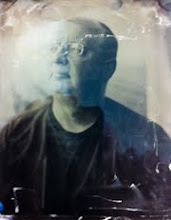Title: "Nocturne in Black and Gold"
In an interview in Modern Painters, Susan Rothenberg said that a painting should have the figure, the ground and the third thing. I find myself drawn to abstract images because they are paradoxically all about the third thing, the "in between", without necessarily having the figure and/or the ground as formal elements. I tend to categorize those who are drawn to abstract art by their approach to it. Some treat it like an intellectual puzzle, and come to a satisfactory resolution when they can identify some element that can be related to a realistic subject ("oh, I see an owl's face"). I must admit to not being such a person - if ever I see something akin to a realistic element in an abstract work, I can no longer stand to look at the image. It's somehow ruined for me. I am one of those people who respond to abstract images in a "gut" or emotional way. I certainly like to explore how the construction of the image evokes such a strong response, but I don't require some resolution from that exploration to be satisfied.
Looking at today's image made me think of two painters who pioneered the move from representation to abstraction: Monet and Whistler. One of my favourite paintings in the National Gallery of Canada is Waterloo Bridge by Monet. He painted a view of the bridge on a foggy dawn, which in essence required a certain softening and abstraction of the subject. Whistler started a move towards abstraction with his "nocturne" paintings. While these still had realistic subjects, they were successful more because they emphasized shape and tone and a certain darkness. Some of the images I'm getting with the home-made slit lens seem to walk the line between photograph and charcoal drawing, which I find quite exciting.


No comments:
Post a Comment